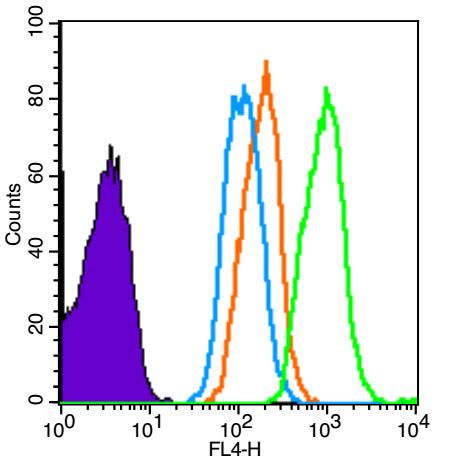
Rabbit Anti-CD1d antibody
Antigen-presenting glycoprotein CD1d; CD1.1; CD1d; CD1D antigen; CD1D antigen d polypeptide; CD1d molecule; CD1D_HUMAN; Cd1d1; differentiation antigen CD1 alpha 3; HMC class I antigen like glycoprotein CD1D; Ly 38; MGC34622; R3; R3G1; T cell surface glyco
View History [Clear]
Details
Product Name CD1d Chinese Name TlymphocyteCD1D抗体 Alias Antigen-presenting glycoprotein CD1d; CD1.1; CD1d; CD1D antigen; CD1D antigen d polypeptide; CD1d molecule; CD1D_HUMAN; Cd1d1; differentiation antigen CD1 alpha 3; HMC class I antigen like glycoprotein CD1D; Ly 38; MGC34622; R3; R3G1; T cell surface glycoprotein CD1d; Thymocyte antigen CD1D. Research Area Tumour immunology Signal transduction transcriptional regulatory factor Cell Surface Molecule t-lymphocyte Immunogen Species Rabbit Clonality Polyclonal React Species Human, Applications ELISA=1:5000-10000 IHC-P=1:100-500 IHC-F=1:100-500 Flow-Cyt=1ug/Test (Paraffin sections need antigen repair)
not yet tested in other applications.
optimal dilutions/concentrations should be determined by the end user.Theoretical molecular weight 36kDa Cellular localization cytoplasmic The cell membrane Extracellular matrix Form Liquid Concentration 1mg/ml immunogen KLH conjugated synthetic peptide derived from human CD1d : 101-200/335 <Extracellular> Lsotype IgG Purification affinity purified by Protein A Buffer Solution 0.01M TBS(pH7.4) with 1% BSA, 0.03% Proclin300 and 50% Glycerol. Storage Shipped at 4℃. Store at -20 °C for one year. Avoid repeated freeze/thaw cycles. Attention This product as supplied is intended for research use only, not for use in human, therapeutic or diagnostic applications. PubMed PubMed Product Detail This gene encodes a divergent member of the CD1 family of transmembrane glycoproteins, which are structurally related to the major histocompatibility complex (MHC) proteins and form heterodimers with beta-2-microglobulin. The CD1 proteins mediate the presentation of primarily lipid and glycolipid antigens of self or microbial origin to T cells. The human genome contains five CD1 family genes organized in a cluster on chromosome 1. The CD1 family members are thought to differ in their cellular localization and specificity for particular lipid ligands. The protein encoded by this gene localizes to late endosomes and lysosomes via a tyrosine-based motif in the cytoplasmic tail. Two transcript variants encoding different isoforms have been found for this gene. [provided by RefSeq, Jan 2016]
Function:
Antigen-presenting protein that binds self and non-self glycolipids and presents them to T-cell receptors on natural killer T-cells.
Subunit:
Heterodimer with B2M (beta-2-microglobulin). Interacts with MHC II.
Subcellular Location:
Cell membrane, Single-pass type I membrane protein. Basolateral cell membrane; Single-pass type I membrane protein. Endosome membrane; Single-pass type I membrane protein. Lysosome membrane; Single-pass type I membrane protein. Endoplasmic reticulum membrane; Single-pass type I membrane protein. Note=Subject to intracellular trafficking between the cell membrane, endosomes and lysosomes.
Tissue Specificity:
Expressed on cortical thymocytes, on certain T-cell leukemias, and in various other tissues.
Similarity:
Contains 1 Ig-like (immunoglobulin-like) domain
SWISS:
P15813
Gene ID:
912
Database links:Entrez Gene: 912 Human
Omim: 188410 Human
SwissProt: P15813 Human
Unigene: 1799 Human
Product Picture
Primary Antibody (green line): Rabbit Anti-CD1D antibody (SL23491R)
Dilution: 1μg /10^6 cells;
Isotype Control Antibody (orange line): Rabbit IgG .
Secondary Antibody (white blue line): Goat anti-rabbit IgG-AF647
Dilution: 1μg /test.
Protocol
The cells were fixed with 4% PFA (10min at room temperature)and then permeabilized with PBST for 20 min at room temperature. The cells were then incubated in 5% BSA to block non-specific protein-protein interactions for 30 min at room temperature .Cells stained with Primary Antibody for 30 min at room temperature. The secondary antibody used for 40 min at room temperature. Acquisition of 20,000 events was performed.Blank control (Black line): Molt-4 (Black).
Primary Antibody (green line): Rabbit Anti-CD1D antibody (SL23491R)
Dilution: 1μg /10^6 cells;
Isotype Control Antibody (orange line): Rabbit IgG .
Secondary Antibody (white blue line): Goat anti-rabbit IgG-AF647
Dilution: 1μg /test.
Protocol
The cells were fixed with 4% PFA (10min at room temperature)and then permeabilized with PBST for 20 min at room temperature. The cells were then incubated in 5% BSA to block non-specific protein-protein interactions for 30 min at room temperature .Cells stained with Primary Antibody for 30 min at room temperature. The secondary antibody used for 40 min at room temperature. Acquisition of 20,000 events was performed.
References (0)
No References
Bought notes(bought amounts latest0)
No one bought this product
User Comment(Total0User Comment Num)
- No comment



 +86 571 56623320
+86 571 56623320
 +86 18668110335
+86 18668110335

